Text
Sean Yoro: Taking Street Art to the Next Level
Sean Yoro is a street artist like no other. The Hawaiian artist has been creating magnificent, almost photo-realistic portraits of women on walls and surfaces around the world. Usually adjacent to rivers or lakes, Sean’s work seems to emerge from the water as he crafts it from the comfort of his paddle board.

Sean combines the beauty of portraiture with nature, He brings to life the world’s most unexpected canvases.
“The ocean and my connection to water has always been a main inspiration for my artwork. I had been working on some underwater photoshoots when the concept first hit me. I considered how fun it would be to work in the water, on a SUP board, instead of cooped up in my art studio. From there the pieces fell together,” explains Sean.

vimeo
Each mural takes anywhere from 10 to 24 hours to complete. They begin like most portrait works - by photographing his subject. “I usually don’t try to plan every pose ahead of time,” he explains. He likes to keep things organic to allow for his subject’s personality to shine through. “I’ve always been drawn to the subtle emotions of portraits - the emotions that you can only get hints of - if you look deep enough.”

Sean’s work is now becoming internationally recognized and acclaimed, but the artist hasn’t been at it for very long. He first gained an interest in street art when he was a teenager and fell in love with graffiti around Oahu (hot link) where he lived. He began sketching in his notebook and didn’t take any art classes until he reached college. “I dropped into a fine art class and learned how to paint the human figure. From that point, the game changed for me. I moved to New York the following summer to chase my dreams of becoming an artist,” adds Sean.


To learn more about Sean Yoro’s work or to buy prints of his ephemeral art, please visit his website.(hot link)
Join zeeBigBang - where arts and entertainment mean business.
#art#street art#portraiture#painting#graffiti#models#hawaii#paddle boarding#visual arts#beautiful#toronto#zeebigbang#zeebigblog
3 notes
·
View notes
Text
Shen Yun: Bringing To Life an Ancient Art
Shen Yun Performing Arts is a performing-arts company from New York City that celebrates traditional Chinese folk and story-based dance. Made up of over 200 dancers, the company tours 130 cities around the world bringing to life ancient stories and traditions.
youtube
“As cultivators, Shen Yun artists’ have different starting points and creative concepts—we seek to strengthen what is good and pure, and we use traditional elements in our choreography,” explained Yungchia Chen, a choreographer for Shen Yun, in a press release. “Shen Yun is a world leader in terms of reviving traditional culture. That’s our mission, and the basis for everything we do. We want to send a message that gods exist, that what we do has consequences—good is rewarded and evil is punished, and that there's hope for the future.”
The show was started in 2006 by members of a Chinese spiritual practice called Falun Gong. They wanted to encapsulate and celebrate over 5000 years of Chinese traditions and culture, which they feel are being destroyed by the political and cultural state of modern China. Local Falun Gong associations around the world host the performance, which has grown dramatically since its inception.
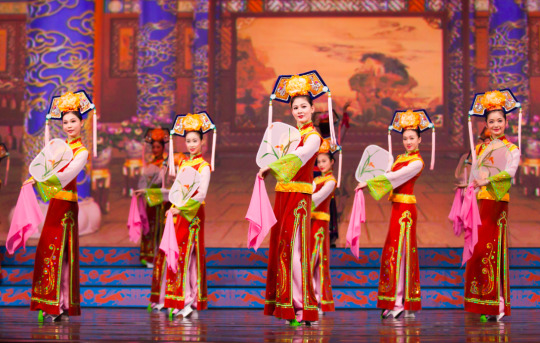
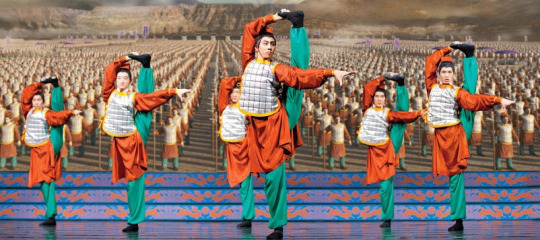
The group is composed of three performing arts companies, namely The New York Company, the International Company, and The Touring Company. The dancers perform what is known as classical Chinese dance, which is known for incorporating a lot of acrobatic and tumbling techniques. The flowing dresses and intricate costumes worn by the performers are also a wonder for audiences. They reflect various Chinese ethnicities and characters, soldiers, and court dancers.
Additionally, the dances pull on ancient Chinese narratives such as the Legends of Mulan and Outlaws of the March. They also incorporate the stories of Falun Gong practitioners in the modern Chinese world.
“In trying to revive traditional culture, we have to comply with its values and thinking. Our ‘returning to the traditional’ can’t just be for show. The ancient Chinese had great faith and respect for the divine. As modern people, we have to change the way we think, and purify our minds bit by bit,” adds Yungchia Chen.

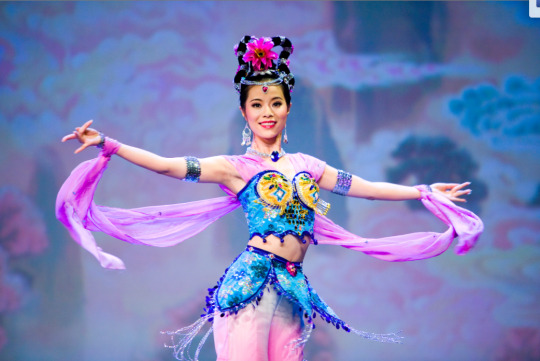
To learn more about Shen Yun, please visit their website.
Join zeeBigBang - where arts and entertainment mean business.
#dance#art#performance art#shen yun#chinese dance#chinese art#chinese music#world tour#culture#tradition#Toronto#zeebigbang#zeebigblog
5 notes
·
View notes
Text
Taking flight with Kate MccGwire
“I gather, collate, reuse, layer, peel, burn, reveal, locate, question, duplicate, play and photograph,” is how world renowned British sculptor Kate MccGwire describes what she does.
What truly separates Kate as a sculpture is her choice to use feathers as her working medium.


Kate’s innovative and complicated creative process started when she was a child living in the rural area of Norfolk in the U.K. Her father, a boat builder, would bring his daughter to work with him, where she would spend the day playing by the river and in the boats. There she took in the untouched nature that surrounded her.
“My parents were constantly telling me that I was always very observant as a child, seeing lots of birds and animals that other people wouldn’t see, looking through the reeds and things,” Kate explains. “So I’ve always had an interest in animals and specifically birds. I was constantly collecting feathers as a child.”
The theme of nature was an integral part of Kate’s career as began to develop her artistry, working with feathers to recreate patterns and visuals found in water, air, and other natural phenomena.
“I moved to my studio in 2005, which is on a boat on the Thames [River]. So again, we get this sort of lying alongside nature all the time,” explains Kate. “At the moment the river is running quite fast here in the winter. So you get some very beautiful but treacherous patterns in the water, and the currents could take you underneath if you fell in. But actually on the surface they look very beautiful. So I think of my work as being sort of beauty and treachery at the same time.”
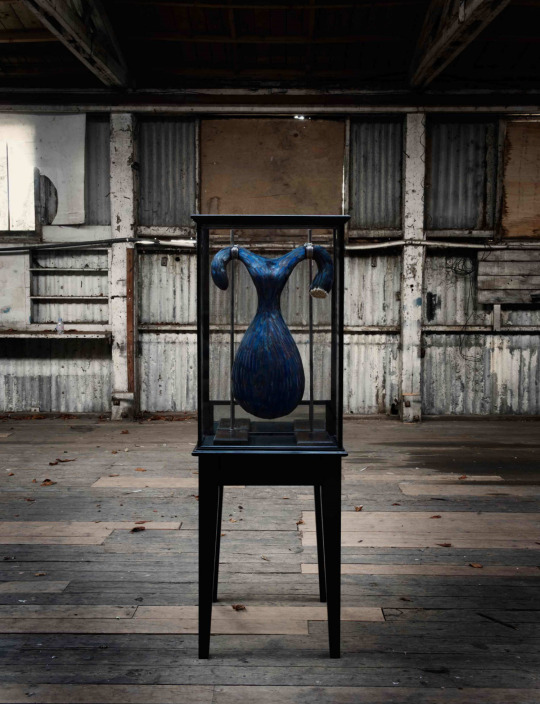

Kate always uses natural mediums in her sculptures from feathers to bones that have been responsibly sourced. The process can take years for a single piece. This gives Kate plenty of time to design and think deeply about how she wants to go about creating the work. The collection of materials informs her process, and is a major part of her creativity.
“A lot of the materials I use you cannot buy. It is a process of negotiation and coercing of people that have the things that I want, that they would normally throw away. For example, for the pigeon feathers I send envelopes to pigeon racing people. I send them drawings and letters telling what I’m doing and thanking them for the letters they’ve sent me before. There will be a stamped self-addressed envelope so all they have to do is put the feathers they would normally throw away in the envelope and send it back to me in the post,” Kate explains. “Otherwise these things would just get thrown away. I like the fact that it’s a recycling. Sometimes it alarms people; they think I’ve been going around killing thousands of birds to make the work. It’s very important to me that every bird that I use is a form of recycling. They are birds that are disregarded.”


Gathering materials is just part of Kate’s creative process.
The sculpture starts its life as a series of drawings. Kate doesn’t use any 3D computer mapping to plan out the sculpture. She uses her drawings as her only blueprint to begin her work. As she glues and molds the feathers together, Kate concurrently begins to create the casing in which the sculpture will live.
“As I make a piece and I normally find an antique cabinet or dome. Then I make the work that will fit that space - make the work look like it has been trapped. There’s very little space between the dome and the glass sides and the piece itself. It looks like it’s squirming around within that space. I never make a piece of work and then try and find the dome because it would be impossible to find one that absolutely fits the shape that I’ve made. I want the shape of the enclosure to really impact the shape of the piece,” explains Kate.
“Entrapment. I want the piece to look like it’s writhing; that it’s tormented within a smaller space. That it’s alive and it wants to get out. I think of these pieces as being a three dimensional manifestation of a state of mind, so constantly, slightly in turmoil, but beautiful, and anguished at the same time. There’s this constant sort of aesthetic and discomfort at the fact they look like they’re trapped.”



To learn more about Kate MccGwire and her work, please visit her website.
Join zeeBigBang - where arts and entertainment mean business.
#sculpture#kate mccgwire#art#modern art#contemporary art#cool art#new art#design#structure#toronto#UK#Canada#zeebigbang#zeebigblog
6 notes
·
View notes
Text
Murmurs: What does sound feel like?
An interactive exhibition in Toronto is challenging people to experience music beyond sound - to explore the look and feel of music.

vimeo
Walking into The Great Hall in Toronto’s trendy Queen West neighbourhood, the energy is noticeably strong. The rooms are filled with artistic, young, and fascinated participants exploring the various interpretations of sound developed by the artists.
Murmurs aims to capture the essence and sentiments of listening to a song through various digital media that include light installations, experimental video and projections, virtual reality experiences, motion graphics and other interactive exhibits,
Inspired by five songs created by notable Canadian artists, 21 artists have collaborated to create 15 interactive installations for the event.

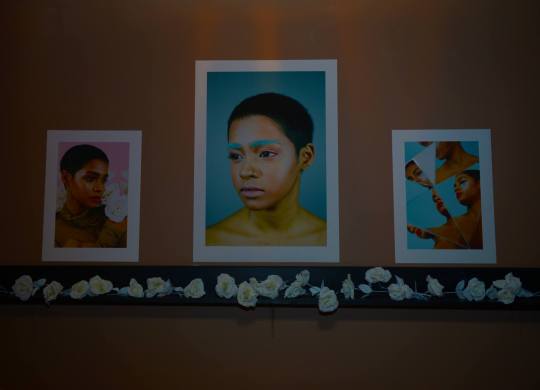
youtube
River Tiber - No Talk - one of the songs used in the Murmurs Installations
The music plays through the entire venue, and you’re free to move from installation to installation, and to figure out how each is a reflection of the songs you’re hearing. Some pieces invite reflection, such as the giant melting sphere of ice located in the centre of the room. Other pieces asks the observer to contribute, and draw or colour a portion of the artwork.



One of the most fascinating installations is the virtual reality (VR) exhibit created by Outpost VR. Several plushy bean bags lay on the floor, occupied by people engaged in an entirely different world. Through the VR headsets they wear, they are transported to a variety of new locations, each filmed to match the tone of a song. The VR footage changes with the songs, and takes the participant from Toronto, to a dense forest, to a rap battle, and finally to a South African slum.
The experience is so immersive, most participants completely leave behind the environment of the actual room they’re in. Watching them laugh, reach out to try and touch the things they’re seeing, and just be fully engaged in their VR experience offers people on the outside a seriously futuristic sight.


The experimentation taken by the artists and organizers of this event has pushed the boundaries of the future of music and art.
By merging our senses, the experience of music becomes far more engaging, and well rounded. The exhibitions also offer examples of how new technology can be utilized to enhance our experiences of music and art, and provide us with a glimpse of what’s to come.
To learn more about Murmurs, please visit their website.
Join zeeBigBang - where arts and entertainment mean business.
#music#installation#live art#exhibitions#VR#virtual reality#avante garde#modern art#contemporary art#paiting#performance#music video#art experience#toronto#murmursto
3 notes
·
View notes
Text
Kacper Kowalski: taking photography to new heights
Kacper Kowalski is a trained architect who gave up his career to pursue his true passion - photography.
Kacper combines his love for photography with his love for flying. He points his lens down from the sky and capturs some of the most incredible aerial photographs of the Earth.

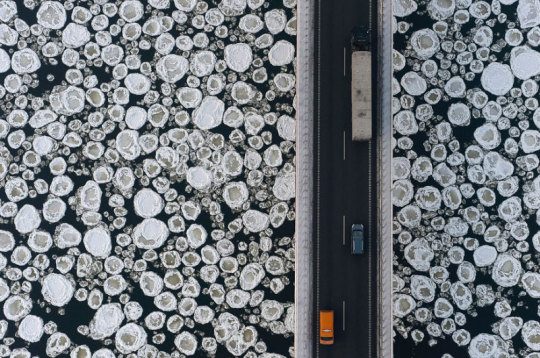
Born in Poland in 1977, Kacper dreamed of being a pilot - like a lot of little boys do. Except Kacper fulfilled his dream and got his license to fly planes and started flying as soon as he got the chance. The panoramic sights he was able to see stirred his emotions.
“From above, the complex relationship between nature and humans becomes more visible,” explains Kacper. “I started exploring this relationship in my photos, and asking questions through my work. Is this virgin landscape or has the land adapted to human needs? What is the natural environment for human beings? Things like that.”
Kacper never uses a drone, and the camera is never remote controlled. Flying solo, Kacper takes time to reflect, and captures his images, usually of Poland, about 150 metres above ground. His work offers a graphic and sometimes abstract portrait of civilization and nature.
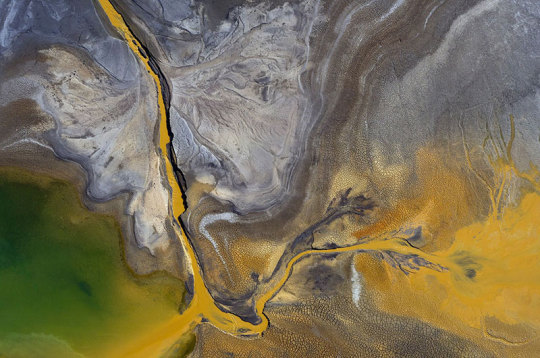


More recently, Kacper has begun incorporating his architectural background into his work, designing and creating composite images. “Architecture was a big part of my life, it was a huge passion of mine, and still is,” explains Kacper. “When you’re designing any architectural structure, the first step is to understand the location and context, and as a photographer, I use the language of drawing. And just like with architecture, my audience is wide and my subject is civilization.”
His aerial photography and composites were published in his first photography book titled Side Effects. The book’s cover featured a heat-sensitive colour changing ink, representing the lucid impact humans have on the world’s landscapes. “Documentary was easy; it was just simple observation,” Kacper adds, “but I’m not neutral any more, and I feel good with it.”

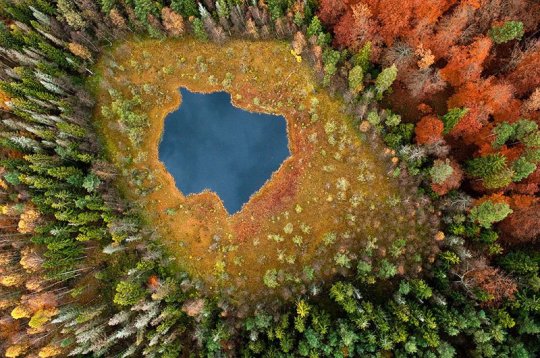

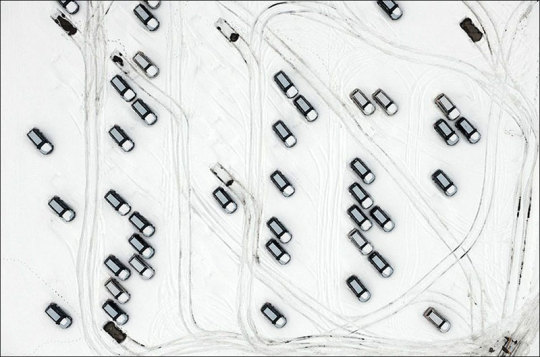
Kasper’s work has gained him international recognition as well as a number of awards at the Sony World Photography Contest. But for Kacper, the content of the pictures is the less important than the reflections and reactions that arise from looking at it. “I would like the project to be a starting point for discussion about what is good or bad, necessary or optional, in the relationship between humans and nature,” explains Kacper.
To learn more about Kacper and his work please visit his website.
Join zeeBigBang - where arts and entertainment mean business.
#photography#aerial photography#google earth art#kacper kowalski#poland#europe#art#photo#image arts#toronto#zeebigbang#zeebigblog
0 notes
Text
Foley Artists: The Unsung Heroes
There’s an element to movie magic that, if done well, isn’t noticed at all.
The sounds that work together to create the acoustic environment of a movie scene, are most often made artificially in a studio by the unsung heroes of the film industry: Foley Artists.
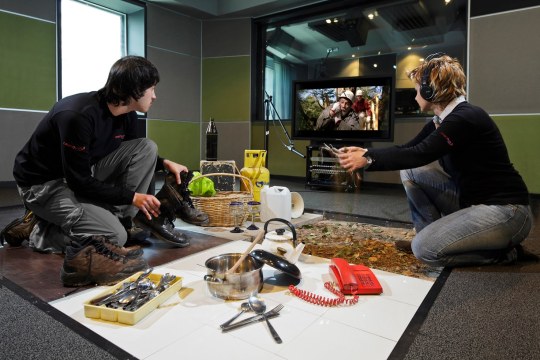
Foley artists at work in the studio.
It goes far beyond using coconuts to make the sound of horse hooves. A Foley Studio is a labyrinth of props, surfaces, costumes, and audio equipment. Everything from silverware to dried up leaves is used to meticulously create the sounds that enrich a film or TV show.
Monique Reymond, is an Emmy award-winning Foley Artist, with 40 pairs of Foley shoes in her studio. “At a minimum, I cover all of the human sounds. By this I mean footsteps, hand pats and grabs, and props that the folks onscreen handle. This does not preclude animal sounds, we do animal footsteps and movement as well,” explains Monique.
“Some of the Foley legends will do far more than just the human sounds. They will do huge impact sounds. For example, I heard about a Foley Artist that covered the sound of a train chugging along and screeching to a halt on the tracks for a film that featured a very long train sequence. The fact that they covered the train in foley instead of recording an actual train blew me away,” Monique said.
Used to enhance the auditory experience of a film, Foley Artists create ambient soundscapes and re-create everyday sounds using sometimes unexpected tools. For example, the sound of a train is often created using a box of macaroni, fire is usually crinkling plastic, and ice cracking can be created using a pinecone. The results are sounds that are sometimes very different from what the thing sounds like in real life, but the artificial sounds are richer and more exciting.
youtube


Foley artists work with an audio engineer to master their sound effects. A good audio engineer can make a small sound seem like it’s coming from a giant object, or add the digital effects that develop the sounds even further. This is particularly important in animated films, where Foley and sound designers are essentially designing the sounds of an entire world.
“I don’t really know how to articulate how important the engineer is in the entire process,” said Monique. “It’s more important than anything. It’s more important than the props I have to use; it’s more important than the stage I have to use; it’s more important than the show I’m working on. I’d have to say it’s singularly the most important thing. The whole Foley process is hugely collaborative, and it takes a lot to create a truly engaging, and rich soundscape.”
youtube

The process for a medium budget feature film takes about 5-10 days, which is incredible when compared to how long it used to take before the advances in recording and editing technology. Foley artists had to create Foley instruments that could recreate sounds over and over and at a variety of speeds, since editing sounds was a much more strenuous process. Today, with pro-tools and extremely sensitive recording technology, artists can focus on create more interesting and detailed sounds.
“I’m definitely resourceful and I will find things and use them. Some of the creativity comes from, in my experience, trying to make do. Working at little boutique studios, they don’t have everything that one needs, literally. So trying to figure out how to make a wide range of sounds working with very little is, I think, a great part of the creativity,” explained Monique. “On the other hand, having done this for 11 or 12 years, a lot of times movies have someone riding a horse. Not as much in contemporary films, but I did a lot of old movies where I did the Foley. And I’ve always faked it with some cool leather creaks and some belts I use as reins, but the other day I was somewhere that actually had a saddle and I got to use the saddle for the creaks. And it sounded so good, I was like, oh my god, I can’t believe I’m finally getting to use this thing!”
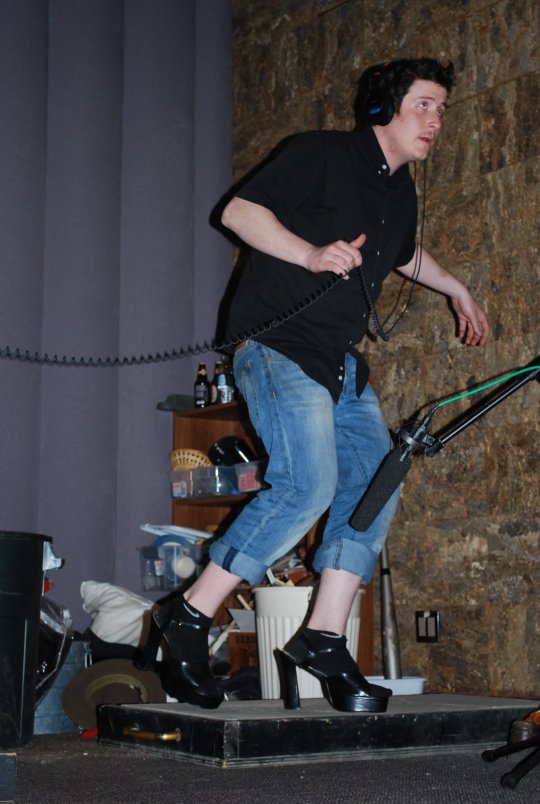

To learn more about Monique and her work as a foley artist, please visit her website.
Join zeeBigBang - where arts and entertainment mean business.
#film#foley#foley artist#sound design#movies#hollywood#animated film#animation#music#sound effects#SFX#zeebigbang#zeebigblog#toronto
0 notes
Text
Painting with the colours of the mind
In 2001, John Bramblitt went blind because of epilepsy. A year later he picked up a paintbrush, and never looked back.
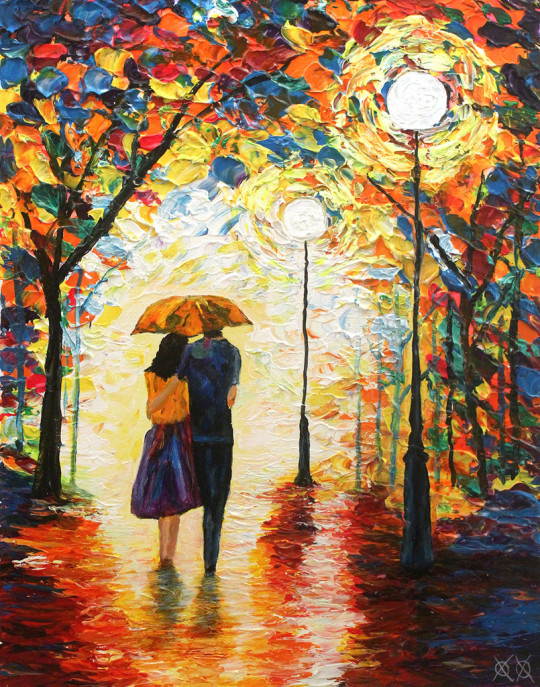

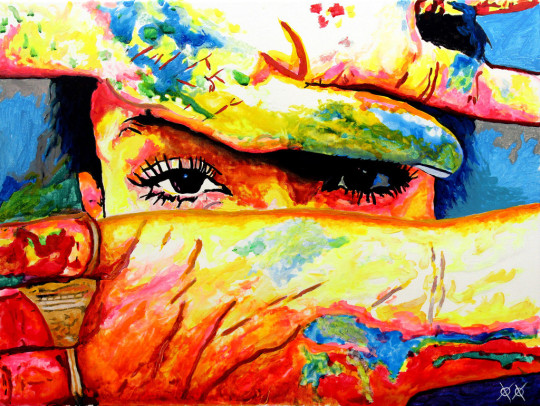
Bramblitt was born in Texas and has lived with epilepsy his entire life. He was always an artist but never used paint or colour until his condition robbed him of his vision when he was 30 years old. “My eyes are perfect but the part of my brain that makes the images just doesn’t work anymore,” explains Bramblitt. His blindness put him into a dark depression, out of which he saw only two ways - suicide or art.
He decided that painting would allow him to create art using his sense of touch. At first, he used quick drying acrylic paint to create raised lines on paper which would allow him to feel out what he was creating. Eventually, he learned how to draw again, and soon after started incorporating colour into his work.

There are over 200 different receptors in the human fingertip, and Bramblitt has learned to feel out the various colours he is working with. “If I'm working with black it'll be runny almost like oil and if I'm working with titanium white it's like toothpaste. So if I want a gray halfway between, I just mix for a texture that's halfway between that really loose feeling and that really thick feeling,” says Bramblitt.
John has also mastered the skill of haptic visualization, a technique used by blind people that allows them to “see” things in their heads through the use of touch. Haptic perception is an important mental tool used by those who have gone blind but have had vision in the past.
John uses it to draw incredible life-like portraits. He develops a detailed 3D model of their face in his mind, and works from memory. "If I want somebody to look to the left or to the right for my painting, I don't need to have that person actually do that because I have this 3D model,” he explains. "And once it’s there, it sticks. Someone whose face I felt five years ago -- I can still paint them. And they never age, which is a great thing."
John’s gotten so good at it, he was able to re-create a strikingly photo-realistic image of his son, whom he has never actually seen.


Since he started painting, John has been exhibited and sold artwork around the world. He also gives talks at the Metropolitan Museum of Art in NYC, and has authored the award winning book, Shouting In The Dark.
But more important for John is the positive impact art has had on his life personally. Saving him from a life of darkness, it has allowed him to evolve and grow as a person when the odds were stacked against him. Art provided him with an outlet to escape, and in return let him truly find his artistic self.
“Everyone has an artist somewhere in them; sometimes they just need a little help letting it out.” says Bramblitt. "The painters I admire are the ones who work really hard at their craft. They're always coming up with new ways to do something. And when they're done, people say, 'Oh, they're gifted and that's interesting.' I don't know if it's a gift or it's just that they're obsessive. Like if I want to make a certain line or a certain colour, I'll work on it forever."

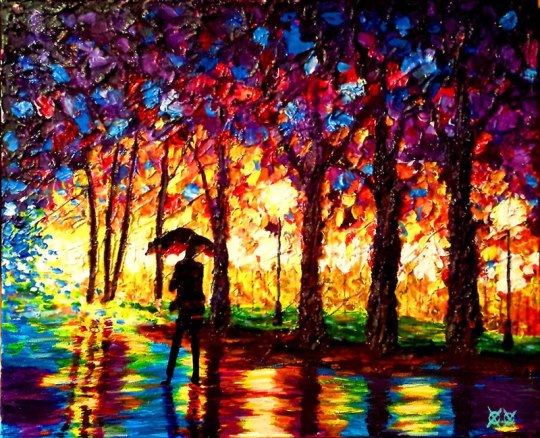

To learn more about John and his work, please visit his website.
Join zeeBigBang - Where Arts and Entertainment mean business
#art#painting#blind#painter#visually impaired#visual arts#arts and entertainemnt#texas#Toronto#zeebigbang#zeebigblog
0 notes
Text
Modern glass sculptures: window sandwiches
Modern day artists are expanding their horizons and creating new, imaginative ways to use glass in their art.

Glass may be one of the most difficult mediums to work with but the variety of things that can be done with glass is incredible. Traditionally glass has been used in stained glass and blown glass works. Now, Brooklyn based artist Dustin Yellin, has created a series of glass sculptures after being commission by the NYC ballet to create a series of figurative collages.
The sculptures are made of sheets of glass each embellished with various objects, such as magazine clippings, trash, and paint.


“Imagine if you were to make a drawing on a window,” said Yellin, explaining his process. “And then you were to take another window and glue it to that window… until you had a window sandwich. I make window sandwiches.”
The resulting sculpture is the figure of a dancer suspended in motion inside the glass frame. Each “window sandwich” weighs around 3000 pounds and contains microcosmic scenes inside each figure. ”It’s the idea that all of your memories are stuck inside your bone marrow, and if you could open that up so everyone could see it,” explained Yellin.
youtube
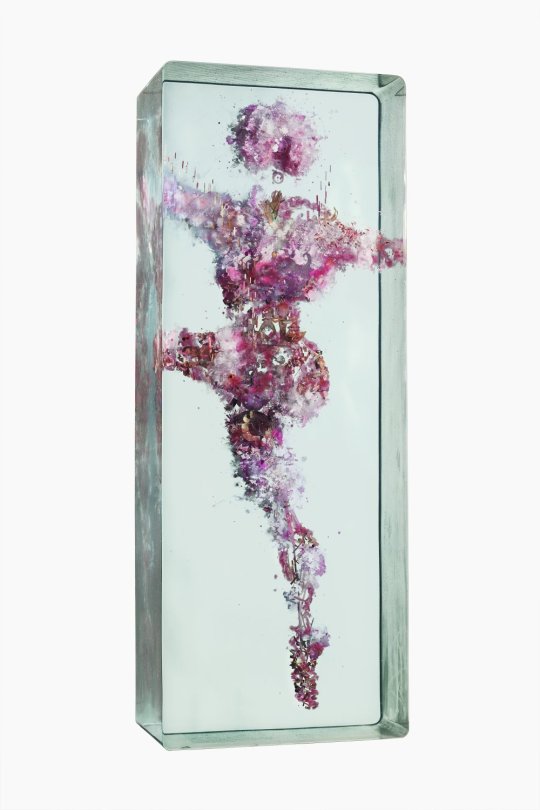
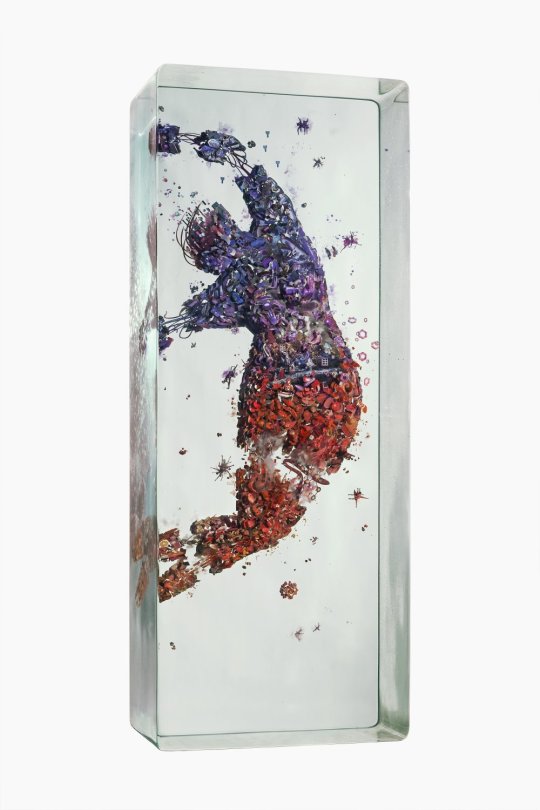
Another artist working with glass layering, paint and perspective to create amazing works of art is Austrian artist Thomas Medicus. He started working with glass by staining it and playing with light. Medicus later moved to carving into glass and using it as a tool for illustration. His latest is a rotating glass sculpture containing four “hidden” anamorphic paintings. The piece is built from 160 glass strips that are hand-painted using the same paint used in stained glass art. The glass strips are stuck into a wooden base with laser cut slits, and when the base is rotated 90 degrees, a new image is revealed.


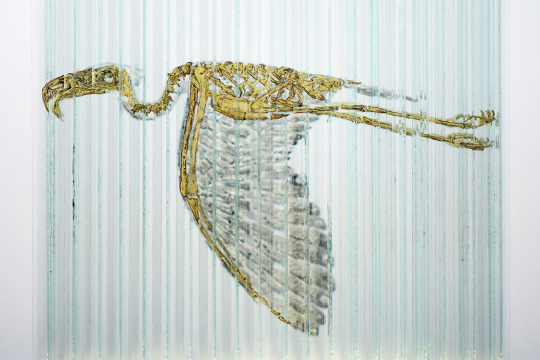
“Through a plug system made out of 216 laser cut acrylic glass strips, a translucent cubic framework is created. On each side of the piece there is one anamorphic painting that is always only visible from one point,” explained Thomas.
“Since every figure fills the exact same surface as its counterpart on the opposite side, the rear image is covered while looking at one figure. Before painting the fragments of the images separately on the strips with acrylic paint, the segmentation has been planned entirely. In order to prevent irritating reflections within the strips and to give it the look of solid glass the sculpture floats in a particular silicone oil that has the same refractive index as acrylic,” Thomas added.
vimeo

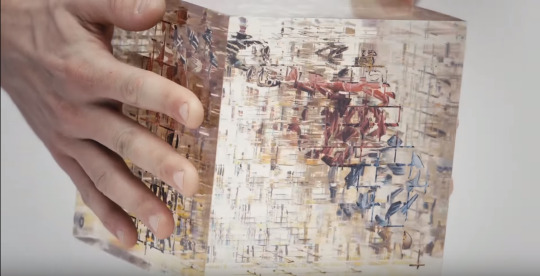
To learn more about Thomas Medicus and Dustin Yellin please visit their websites.
To learn about glass blowing, another incredible form of glass art, please check out our article on Dale Chihuly.
Join zeeBigBang - where arts and entertainment mean business.
#glass art#window sandwiches#dustin yellin#thomas medicus#stained glass#art#design#painting#Toronto#zeebigbang#zeebigblog
1 note
·
View note
Text
Tibetan Sand Painting
The artistic genius that goes into the creation of a Tibetan mandala is staggering.
The mandala is a symbol of the universe in many eastern and Indian religions. A microcosm of everything, the circular, symmetrical, and colourful designs that create mandalas have been around for thousands of years. Tibetan monks have created these designs out of colourful sand, in a meticulous and laborious process, for countless generations.
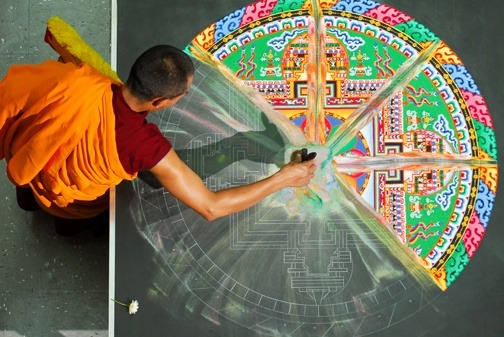

It is a tradition in Tibetan Buddhism to create mandala’s out of sand and dismantle them just 14 days later. A sand mandala is ritualistically dismantled once it has been completed and its accompanying ceremonies and viewing are finished to symbolize the Buddhist doctrinal belief in the transitory nature of material life.
Typically, sand mandalas are not made of regular sand that’s been dyed, but rather from crushed colourful rock.
The process begins with monks drawing out a geometric pattern, which acts as a blueprint, over which the sand will be layered. The sand granules are then applied using small tubes, funnels, and scrapers, called chak-pur until the pattern is created.
Sand mandalas traditionally take several weeks complete. It is common for a team of monks to work together on a project, creating one section of the diagram at a time, working from the centre outwards.
youtube

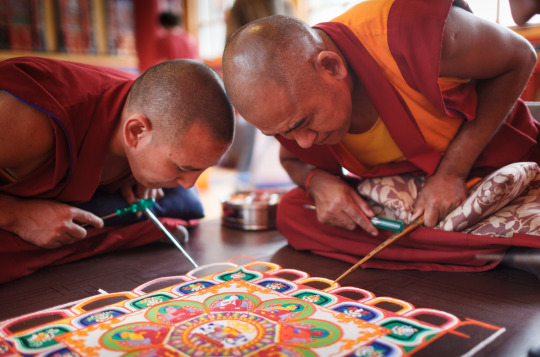

The intricate design of the mandalas aren’t just geometrical; they feature a variety of different themes and stories.
The Kalachakra Mandala for instance, portrays 722 deities, and represents the ‘wheel of time.’ It also alludes to a very complex and esoteric Tibetan Buddhist teaching.

The Kalachakra Mandala
Another mandala is the Chenrezig, which represents the embodiment of the compassion of all Buddhas combined. To echo the spirit of compassion, the participating monks will gather in prayer and meditation sessions, also known as puja, at the start and close of each day. Viewers are invited to partake in this ritual as well.

The Chenrezig Mandala
When the mandala is complete, it is ceremonially destroyed. Even the deity syllables are removed in a specific order along with the rest of the geometry until the mandala has been completely dismantled. The sand is then collected in silk and thrown into the ocean, or near body of water to represent the ephemerality of life and the world.
Many Buddhist temples open their doors to the public to view the creation of these intricate pieces, and you can learn more about the practice here.
Join zeeBigBang - where arts and entertainment mean business.
7 notes
·
View notes
Text
Defying Gravity with Mickael Jou
Berlin based artist Mickael Jou has spent the last three years combining two if his favourite forms of art: photography and dance. He is about halfway through his 365 photo project titled Air through my Ashes; a collection of self-portraits that capture the dancer walking on air.



“As a trained dancer, I used to perform ballet and modern dance in the streets of Paris. Tourists would quite often photograph and film me in action in Paris, and after seeing the pictures taken of me, I decided I should try it out,” explains Jou. “And so I bought a camera, and read the instruction manual.”
Jou photographs himself everywhere from cafes and supermarkets, to attics and street corners. He alone plans, art directs, and takes the portraits, and has begun writing pieces to accompany each image that explain his state of mind in the photograph.
“Starting at photo 183, I decided to add writing, documenting my locations and my thoughts,” explains Jou. “So much artistry is intimidating. I think back to when I started photography, I naturally compared myself to others and felt somewhat inferior. I would pore over different photography styles and asked myself if I was embarking on the right path. I took a little from each photographer I discovered and kept on going. And it’s nice to be able to document those thoughts and discoveries alongside the results.”
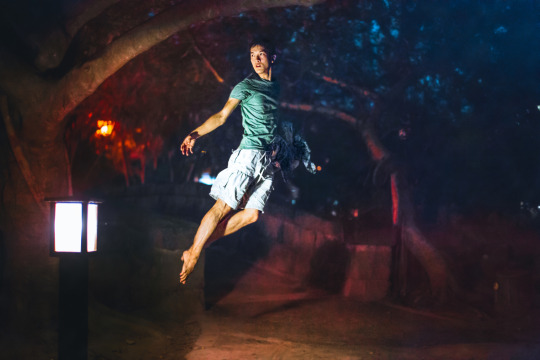

Jou’s astonishing work ethic and commitment to his project is only a sample of the renaissance man in the rest of his life. He is a self-taught dancer, speaks 4 languages, and is a published author. Always setting very high standards for himself, Jou asserts that in his pursuit of artistic excellence, he treasures the journey more than the result.
“When I taught myself German, I sat myself down for 6 hours a day for a month a half and studied. And I actually enjoyed it. I enjoyed learning new words, new grammatical expressions. I enjoyed the intensity. It was fun, and every single word and conjugation gave me this euphoric (and exhausting) feeling that I had embarked on this wonderful path to somewhere new. And indeed, thee months later, I moved to Germany,” recalls Jou. “And over the years, I’ve followed my own path. And then one day I forgot about comparing myself, the “oh he/she might be better.” I forgot to compare myself because I was just enjoying what I was doing. I figured out why I enjoy taking my self-portraits and just ran.”
“I look at the path I’ve covered. I look at the dust rising up in my tracks and I just stare into this not so distant past where I see my own progression and development on this path less traveled.”


Jou’s photographs have been featured in international campaigns by Coca Cola and Lulu Lemon, and can be found on his Tumblr.
To learn more about Jou, please visit his website.
Join zeeBigBang - where arts and entertainment mean business.
#mickael jou#dance#photography#europe#art#performance#tumblr#zeebigbang#zeebigblog#los angeles#toronto
0 notes
Text
Taking shoe design out of the box: Filfury
Phil Robinson, aka Filfury, is a British artist who has managed to turn sneakers into masterpieces. He repurposes the lace, stitching, leather, and logos to form birds, bats, skulls, and insects.
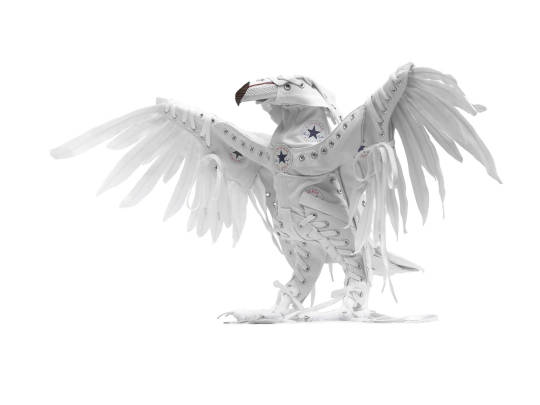

Robson describes his work as “a battle of pop culture vs nature”, and is heavily influenced by his 90s childhood, hip hop, UK garage, and an addiction to sneakers and sportswear.
He began his work digitally, putting the pieces together using Photoshop and creating large prints onto canvas. Since he’s moved on to actually sculpt his designs out of real shoes, bringing his imagined structures to life.
“I get inspired by the form of the shoe and enjoy the idea of repurposing some of my favourite objects,” explains Robson.
“I think about what the shoe reminds me of. I start with the question, ‘Wouldn’t it be cool if…’ I then look for reference pictures of the new object online. I take photographs of the shoe from several angles then jump into digitally painting the pieces together. And now, I’m creating my sculptures with no Macs involved.”


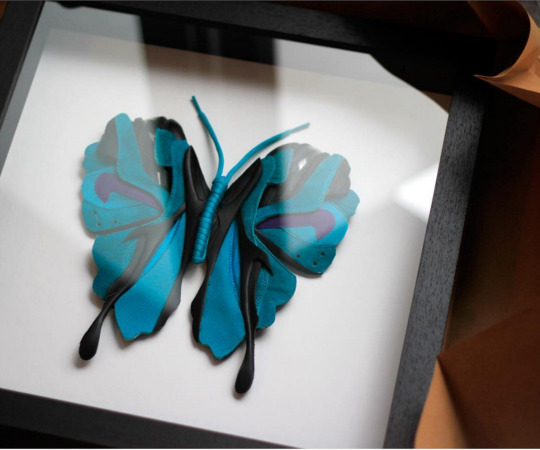
Robson’s work has been exhibited internationally, and he has worked with sneaker brands like Nike and Adidas to create collaborative image work for campaigns and shoe designs. He has amassed a cult following in outlets of sneaker culture, and has tapped creatively into one of the most lucrative industries in the world.
youtube
“The reality is that as an artist there is this major gap you have to bridge between money and creativity. For me there was a time around when my first son was born, that I thought my responsibilities would really restrict me from doing things I loved. So I took what I knew how to do, and what I knew could make money, which is commercials and graphic design, and combined it with something I loved and had around me - my Nikes,” explains Robson. “Do it for the love and if you love it enough it will bring you success - if success equals doing what you love. You just have to learn to work yourself into the market.”
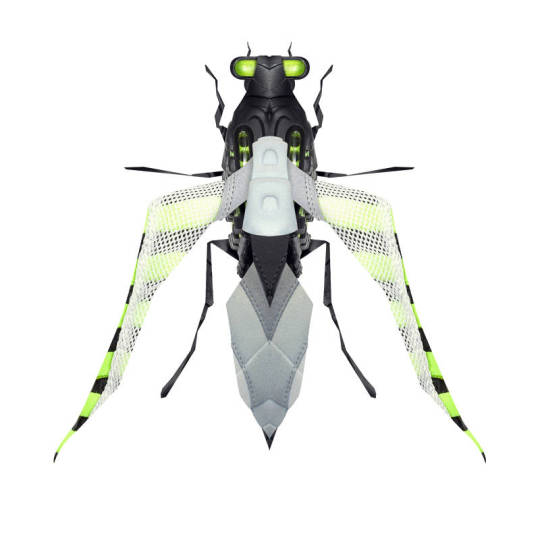
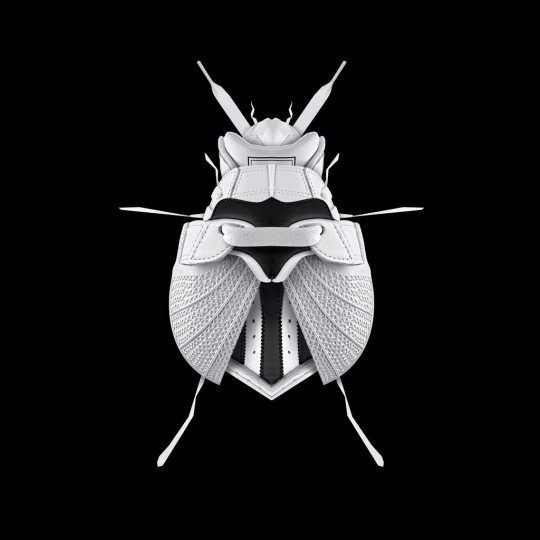
Some of Robson’s pieces are currently on display at SCOPE Gallery’s Art Basel Exhibition in Miami. To learn more, please visit his website.
Join zeeBigBang - where arts and entertainment mean business.
#scuplture#sneakers#sneaker freaker#filfury#insects#shoe art#shoe design#nike#addidas#jordans#toronto#miami#sydney#london#new york#art#Arts and Entertainment#zeeBigBang#zeeBigBlog
1 note
·
View note
Text
Master of Photorealism: Matthew Cornell
Photorealism is perhaps one of the most striking movements in art because there’s nothing quite like realizing that what you’re seeing wasn’t captured by a camera, but was rather meticulously hand-crafted by an artist and a paint-brush.
The movement evolved from the pop-art movement in the late 1960s as a way to reclaim and exalt the value of an image following the advent of photography. Photorealists felt photography threatened to lessen the value of imagery in art and responded against abstract expressionism.
One contemporary master of the photorealism movement is Orlando based artist Matthew Cornell. Holding a Bachelor of Fine Arts from California State University, he describes his paintings as “sublime observations,” dramatized by his careful use of colour and atmosphere.

Ocean

The Road
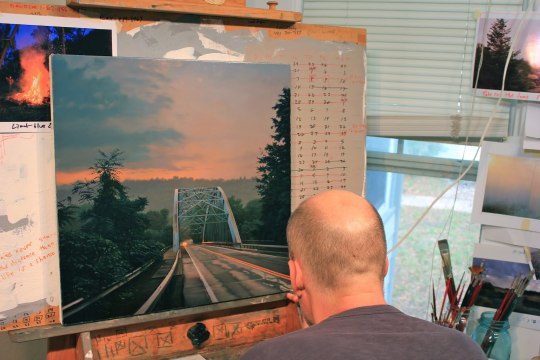
Matthew with his painting Coming Home
Growing up, Matthew’s family moved around a lot, having a significant impact on Matthew as an artist. The constant changing landscape made it difficult for him to garner an anchored self-identity. This, as well as the landscapes themselves, are reflected in his work.
“The landscape in my work is both dramatized in panoramic vistas and minimized in simple paintings of the ocean. Its all created with great detail on a small scale to encourage a more intimate interaction between art and the viewer,” explains Matthew. “All human presence has been eliminated, creating an idealized world where nature again rules.”

Water
Initially, Matthew was purely a landscape artist, but soon got very interested in painting just water. Perfecting the waves and ripples of light became a major artistic goal for him. “Eventually, I got interested in painting house and neighbourhoods, especially ones I was familiar with,” continues Matthew. “I would set up outside around dusk and dawn and paint the streetlights and the roads. Those are the most interesting times for me. When even the most banal scene can seem mysterious.”
More and more of Matthew’s paintings are of familiar old neighbourhoods, and homes with glowing lights inside. He attributes this direction in his work to the recent passing of his parents. His paintings reflect their history, and the different places he grew up. Its an idyllic representation of those memories and has pushed him to create more complex paintings from memory and photo references.

Dusk
“I am beginning to figure out why I am painting what I am painting,” explains Matthew. “I talk all the time about finding home.This longing to find where to live. I spent a great part of my childhood moving and traveling. I have seen this country backwards and forwards. . . I have bothered countless real estate agents to show me houses. Many beautiful things. Every town my wife and I travel through we look at homes and imagine what our lives would be like living there. All of this has been the search for home.”

Lions in Winter

Home before Dark
Matthew’s work has been exhibited across the United States and he has won numerous awards, including first prize in painting at Winter Park Art Festival in 2008 and 2009. His latest exhibition, Pilgrimage, will be opening in March 2016 at the Arcadia Contemporary in NYC.
To learn more about Matthew and his work, please visit his website.
Join zeeBigBang - where arts and entertainment mean business.
#photorealism#paiting#canvas#art#artist#painter#art movement#NYC#California#Toronto#zeeBigBang#zeeBigBlog
2 notes
·
View notes
Text
Mirvish Magic
Mirvish is a house hold name in the Canadian psyche, and a production company that has been bringing the wonder of theatre to Canadian audiences for decades.
Since being founded in 1987 by David Mirvish, it has grown to become the biggest theatrical promoter in Canada, and made Toronto into one the world’s theatrical centres, behind Broadway and London.

Royal Alexandria Theatre, Toronto.
David Mirvish is a modern day renaissance man, and the son of Toronto retailing icon ‘Honest’ Ed Mirvish. It was his father that started the Mirvish theatre tradition when he bought the historical Royal Alexandra Theatre more than 40 years ago.
“I remember that first night at The Royal Alexandra with my father and my mother after we bought the theatre,” says David. “All the critics came up from New York and I feel like they were all scratching their heads and wondering what we had done since my father had completely re-built it and restored it to what it had been in its heyday. I think everyone wished him well but also wondered if he would survive.”
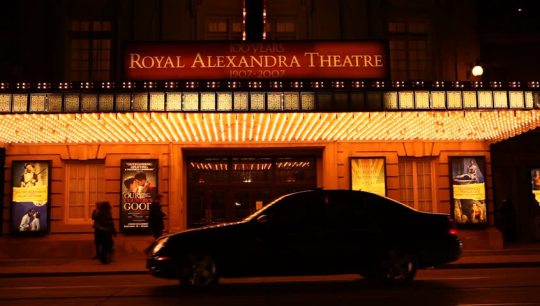
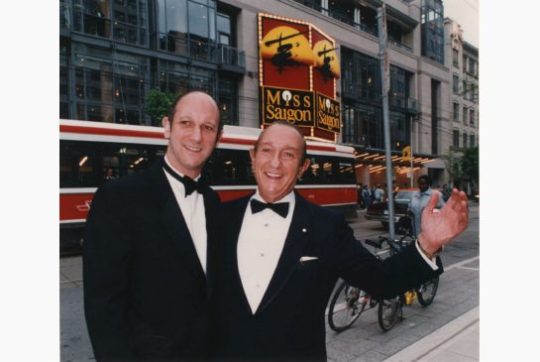
David and Ed Mirvish, founders of Mirvish Productions.
For most of its life up to that point the theatre served as a ‘road house’, a temporary venue for travelling productions. But when David took over the 1500 seat theatre in 1987, he founded Mirvish Productions to produce original works and Canadian stagings of famous musicals. Among the notable early Mirvish-produced and co-produced shows seen at the Royal Alexandra were Brian Macdonald's acclaimed staging of Gilbert and Sullivan's H.M.S. Pinafore.

Gilbert and Sullivan's H.M.S. Pinafore.
Since then Mirvish has expanded, with 4 theatres and over 30 original productions under its belt, the company has made itself a house hold name in the international theatre circuit, and Toronto a cultural capital.
“Theatre has such a long rich history, but sometimes the real joy with theatre is in the moment when an audience falls in love with the show they didn't expect, or the show that they wouldn't have seen if it wasn’t for our work with Mirvish,” adds David. “That's what makes theatre so incredible. It is this collaboration between the audience and the actors. The actors are reading the audience's body language and no single production exists in a vacuum. It's what makes it special and also what makes it dangerous. Of course, some of it is also luck.”
This year’s season has been an astounding success for the Mirvish company, with the overwhelmingly positive reception of Cyndi Lauper’s Kinky Boots, which has been extended for a third time into the new year. The show tells the true story of a man named Charlie Price who inherits a shoe factory from his father. Charlie forms an unlikely partnership with cabaret performer and drag queen, Lola. With Lola's help, Charlie develops a plan to produce a line of high-heeled boots.

youtube
For the holiday season, Mirvish is launching a new staging of the classic Cinderella. To learn more about Mirvish, or to buy tickets to shows, please visit the Mirvish website.
Join zeeBigBang - where arts and entertainment mean business.
#mirvish#mirvish productions#musical#theatre#performance#toronto#culture#kinky boots#cindy lauper#cinderella#play#art#zeebigbang#zeebigblog
0 notes
Text
Rachael Finley: bored teenager turned fashion designer
Rachael Finley, also known as Steak, is a Florida born, millennial it-girl who started two successful clothing lines from scratch. Teenage, and the recently launched Hot Lava, are both hugely popular online fashion lines that reflect the cartoonish, quirky, and colourful style of Steak herself. She’s married to Blake Anderson, star of the popular Comedy Central show Workaholics, but to attribute her success to her Hollywood connection would be a grand oversimplification.

Rachael ‘Steak’ Finley
The ups and downs of Steak’s life experiences have been documented on her Tumblr blog, Steak Talk, which she started after leaving Florida so that she could keep her family and friends up to date on her adventures. It has become one of the most popular online advice columns. Readers from around the world look to Steak for insight into everything from love to fashion. The bold aesthetic of Steak’s personal style has become a fan favourite on Tumblr fashion blogs.
Rachael’s unapologetic fashion sense stems from her career in modelling, which she began after moving to Los Angeles. She quickly found success as a catalogue model and was booking jobs that other models only dream. Despite her success she hated doing it and wanted to do something that was more creative and hands on.

Hot Lava
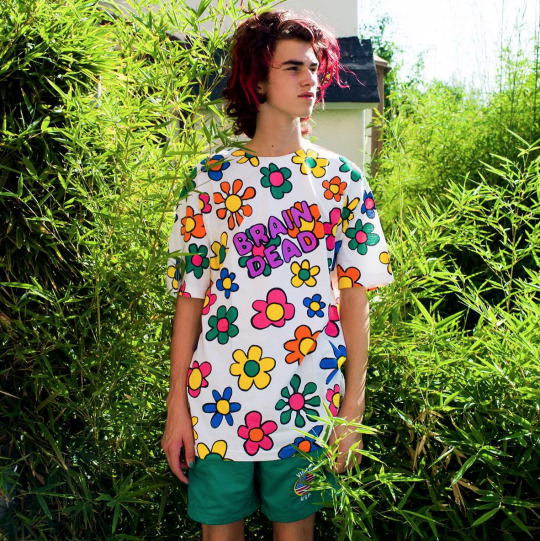
Teenage
“The whole thing with being a catalog and fit model is that they are a stepping stone for girls who want to climb their way up the ladder of the modelling world while making an insane amount of money. Being in front of the camera chipped away at my soul and my intellectual pursuits. I just hated every minute of it and I pined for something to work on that would nourish my soul,” explains Steak.
That’s when her agent started sending her to fitting gigs with higher end fashion houses where when a model is hired, she contributes to the creative process of creating garments and photoshoots.
“High fashion fittings were much different than the standard fitting where you just stand there and are told to keep your mouth shut. Now [fashion fittings] I was encouraged to speak a lot to everyone - to contribute, drape fabrics, come up with ideas. It was such a cool new part of the fashion industry. So creative and happy,” says Steak. “I started phasing out modelling completely. I had been at fashion fittings for about 4 years before I started Teenage. Sitting in on production meetings, picking out fabrics, consulting on trends… it was the best.”

Blake Anderson modelling for Teenage
Steak’s career in the fashion industry was interrupted when she was diagnosed with cancer, and was forced to take a break. Partly out of boredom, and partly out of interest, she began making shirts for her husband to wear on his show. They were looking for something that looked custom made, fit the youthful aesthetic of the show and reflected the millennial angst that came with it. “Unfortunately you can’t just make one shirt. You have to at least make 144… So I sold the rest on my blog and they sold out right away. The rest is 2013 history,” adds Steak.
Since then Teenage has been pumping out new designs, which rarely repeat once they are sold out. Hot Lava, is its sister company, focused on creating clothes for women with the same aesthetic.
“Blake collects what I used to think were the ugliest vintage shirts and now they're all I think about. He has an eye for things. Don't get me wrong though some are still ugly. I think that's the charm too though,” says Steak. “Teenage draws from that completely. Back in the day people were making tees they wanted - not tees that had a 75% profit margin. Back then tee shirts were art pieces and wild looking and expensive to print. That's us.”
Steak’s success in the fashion industry and as a champion blogger, have recently landed her a new show on VICE’s women’s network Broadly. Style and Error explore the relationships between fashion and beauty and their social and political implications.
To learn more about Steak, please visit her website.
Join zeeBigBang - where arts and entertainment mean business.
#fashion#rachael finley#steaktooth#steaktalk#workaholics#design#fashiondesign#teenage#bored teenager#hot lava#hot lava clothing#broadly#VICE#zeebigbang#zeebigblog#toronto#los angeles
7 notes
·
View notes
Text
Experiencing Infinity at The Broad
Situated in the heart of the Los Angeles, the The Broad museum’s architecture acts as a glimpse into the remarkable collection of contemporary art inside its walls.

The Broad, Photo by Iwan Baan
The Broad is the newest and second most expensive museum in LA costing $140 million to build - but entrance to the museum is free.
It was commissioned by billionaire philanthropist Eli Broad and his wife Edythe Broad. In his five-decade long career in business, Eli started two Fortune 500 companies enabling him and his wife to pursue their real passion of philanthropy. They’ve made contributions to medical and scientific research, educational reform, and the arts. They have also spent the last four decades building two of the most prominent personal collections of contemporary art, which are now on display in The Broad museum.
In 1984, the couple started The Broad Art Foundation, an organization focused on spreading public access to art through an enterprising loan program. “We have been deeply moved by contemporary art and believe it inspires creativity and provokes and stimulates lively conversations,” Eli Broad said in a statement. “We hope visitors from Los Angeles and around the country and the world who visit and are similarly enriched by this art.”

Plateau, 2002. By Doug Aitken. On display at The Broad.

Four Women Group, 1998. By Stephan Balkenhol. On display at The Broad.

Obnoxious Liberals, 1982. By Jean‐Michel Basquiat. On display at The Broad.
The Broad museum emphasizes the importance of stimulating thought, inspiring ideas, and appreciating the art of our time.
It features a variety of highly influential artists in the 2000 piece Broad art collection. Artists such as Barbara Kruger, Cy Twombly, and Ed Ruscha, can be found amongst the collection, as well as a growing number of younger, active modern artists.
One of the more modern and hugely popular pieces currently on display is Yayoi Kusama’s Infinity Mirrored Room - The Souls of Millions of Light Years Away. The installation is a mirrored room which reflects infinity LED lights placed strategically around the room. The piece resembles space and its vast infinity, and can only be experienced by one visitor at a time.
vimeo
Created in 2013 by 84-year-old Japanese artist Yayoi Kusama, the installation is about the size of a small bed-room. The floor is a shallow pool of water and the visitor on a small pier right in the middle. The installation then plays with different lighting modes, and induces a variety of sensory experiences.
The work, like many of Kusama’s past works, are a reflection of her mental illness, (what type of illness) which she has experienced since childhood. In fact, she checked herself into a mental facility 40 years ago and has lived and created there ever since. ”By obliterating one's individual self, one returns to the infinite universe," she wrote during a rare interview with Grady Turner in 1999.
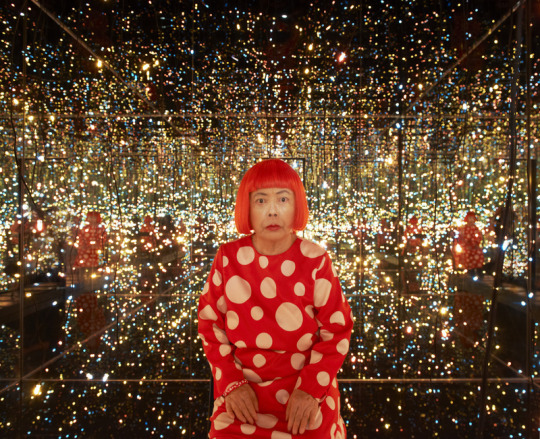
Yayoi Kusama in The Infinity Room at The Broad Museum.
Other powerful and experiential works can be found at The Broad museum. To learn more, please visit The Broad website.
Join zeeBigBang - where arts and entertainment mean business.
#the broad#contemporary art#modern art#pop art#infinity room#jean-michel basquiat#painting#sculpture#installation#los angeles#art collection#The Broad Art Foundation#toronto#zeebigbang#zeebigblog
1 note
·
View note
Text
Donald Chretien: Going back to his roots
Donald Chretien is a Canadian Aboriginal artist whose paintings combine colour and woodland expression that reflect his Ojibwa heritage.
Throughout his 30 year career, he has made the commitment to contribute to his community and create art that reflects the realities and struggles of his roots, aiming to express and teach about the experiences of the First Nation people.

Earth Mother - Muzzu-kummik-quae
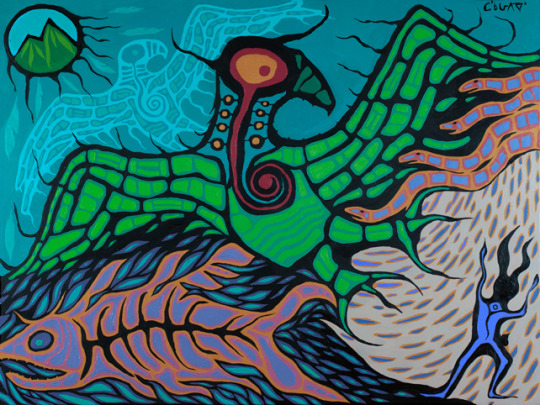
Birch Bark Legend - Weegwauss
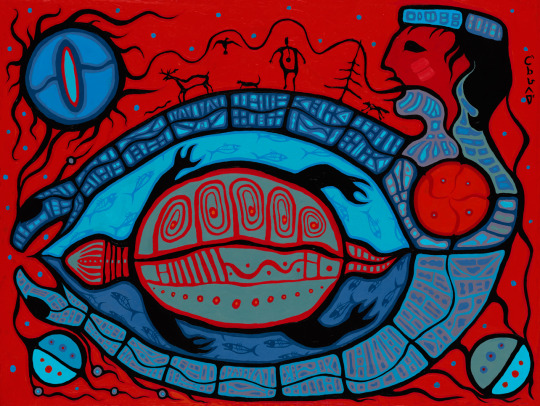
Sky Woman - Geezhigo-Quae
It hasn’t always been this way for Donald.
Donald is half Aboriginal, and while growing up in North Bay, Ontario, his mother advised him to keep his native background under wraps for fear of being discriminated against. So his love for paint didn’t reflect his cultural heritage until much later, and Donald went on to become a very successful commercial artist.
After graduating from the art school, he went on to do everything from animating for feature films, editorial illustration, to logos for casinos in Las Vegas. It wasn’t until 2005, that he decided to go back to his aboriginal roots, and become a full time painter.
“When my mom, who was Aboriginal, passed away, I wanted to make sure I found out the [aboriginal] culture and I needed all the help I could get. I figured I should be retracing my roots, and going back. That’s how all this came about,” says Chretien. “It’s important to me. I feel truly proud of my work now because it’s a reflection of who I am. I believe that if you work hard enough, eventually someone is going to see that and see the passion that’s involved behind it.”
youtube
Donald’s work today is a mosaic of meaning and history.
His paintings use traditional meanings, stories, and reflect the culture and experience of First Nations and other Canadian people. He began his work creating pieces depicting stories about Indian Residential Schools. The series, entitled, Little Butterfly Girl, tells the story of a young girl who gets taken from her First Nation and placed into a Residential School. It depicts the harsh reality of losing one’s sense of self and culture through force; a reality of the history of the Aboriginal people.
“Eventually I got a commission from Vanoc, the committee behind the 2010 Vancouver Olympics, for an 80-foot mural that is now in the Pacific Coliseum permanently,” he recalls. “At this point I took it as a sign this was maybe the right path I should take. I have found out since then that it is definitely the right path I should be taking.”

Donald Chretien standing by his piece Thirteen Moons - Midaaso ashi niswi giizisoog.
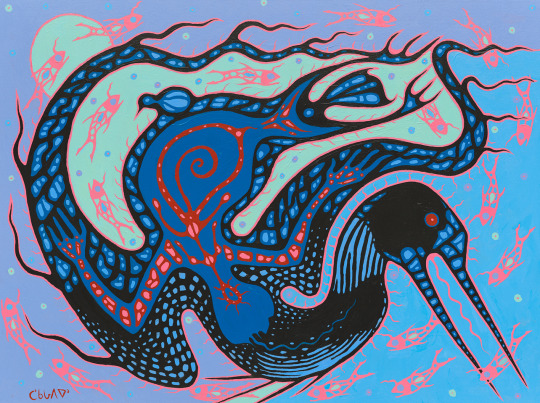
Loon - Maang Dodem
To learn more about Donald and his work, please visit his website.
Join zeeBigBang - where arts and entertainment mean business.
#painting#native art#aboriginal art#Native Canadian art#Donald Chretien#Canada#acrylic#Toronto#Vancouver#new art#zeebigbang#zeebigblog
0 notes
Text
The Changing Face of Make-up in Film
Make-up artists have always been an essential part of the film crew. Transferring the art from theatre, make-up has made the stars on the silver screen more beautiful and more terrifying than anything we would ever see in real life. Directors like George Lucas have long relied on special effects make-up artists to create out of this world characters; and much of the guts and gore we see in film are all done by the make-up team.
The art of make-up has evolved into a new role with ever changing technology. Everything from the development of higher-resolution, 3D cameras, to post-production software like CGI, has had a profound impact on the film make-up industry.
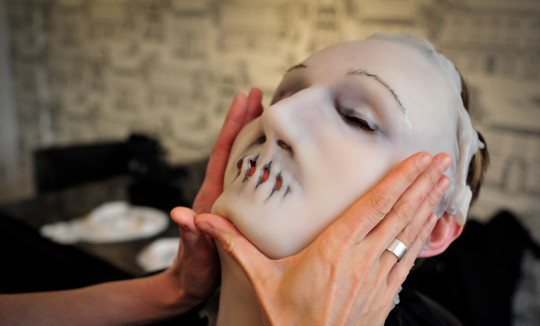
youtube
Technology has replaced some of the work of make-up artists and has simultaneously made higher demands for perfection and artistry.
“A lot of effects that used to be make-up are now often CG, putting SFX makeup artists out of a job! It can often be cheaper and save time to do it 'in post’ with varying results,” explains SFX make-up artist Florence Carter.
Yet high definition cameras of today’s film industry are unforgiving on special effects make-up, forcing artists to evolve higher quality silicone products, and innovate new ways of working. “Airbrushing is increasingly popular as the atomized make-up creates a fine layer of tiny dots on the skin that are less visible on the screen. Airbrushing has been popular for special effects make-up for many years for colouring, shading and when used with stencils,” adds Carter.

Silicone bald cap and mask by Florence Carter.
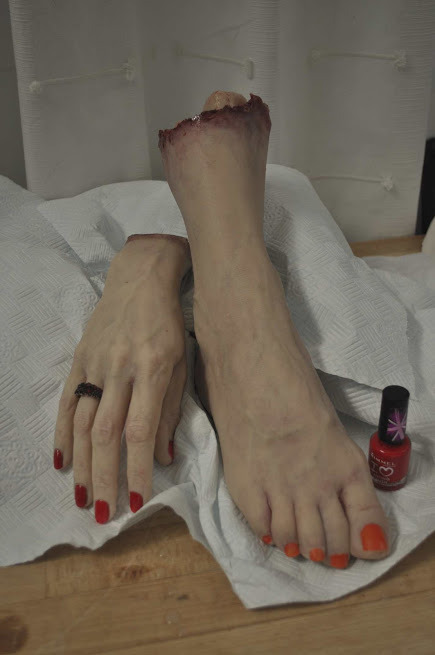
Prosthetic pieces by Florence Carter.
Most recently special effects make-up manufacturers have had to work to develop products that look good in 3D films. Artists can no longer rely on flat angles to make their work look real. They now have to deve lop more extensive and full prosthetic, wax, and silicone pieces that look more real than ever. The development of 3D printing technology has had a profound impact on the creation of such designs, both in the make-up and visual effects industries.
youtube
Rick Baker is a seven-time Academy Award winner for special effects make-up. He was the force behind the look and feel of the characters in Star Wars, The Exorcist and An American Werewolf in London among many other films. He recently took his artistic visions and channelled them through a 3D printer, to help develop the technology and understand how to use it to create visual characters. After several trial and error attempts, he was able to create a Popeye piece doesn’t look like it came from a 3D printer. Make-up innovators like Rick Baker are proving that the way special effects are achieved is constantly changing.
To learn more about Special Effects make-up, or to get inspiration for characters, please visit Florence Carter’s website.
Join zeeBigBang - where arts and entertainment mean business.
#make up#make-up#make up artist#special effects#sfxmakeup#makeup#movie makeup#professional makeup#film#cinema#horror films#halloween#3D Printing#toronto#los angeles#zeebigbang#zeebigblog
0 notes